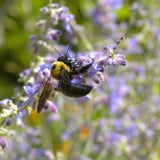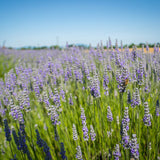20/30cm Pot Grown English Lavender
(Lavandula angustifolia 'Munstead')
English Lavender is highly used in the UK and is quite often used for compact hedging in cottage displays or contemporary design, with its stunning scent and blooms.
- About Pot Grown English Lavender
- Key Features
- Pruning & Care
The Lavandula angustifolia ‰ۡÌÝÌáMunstead,‰ۡó» is a favoured species, for its stunning shrubbery that is easy to grow, compact, and very hardy. It looks perfect in any English cottage garden or countryside site. It is a plant that is often used to get rid of pests, as the scent coming from the Lavender can easily deter them. The plant can be used in many ways in cooking, whether that is in biscuits, cake or tea, and can easily be used as a substitute to Rosemary, interestingly- the citrusy, but sweet-like flowers are even edible too.
In comparison to the Lavender ‰ۡÌÝÌáHidcote,‰ۡó» the English Lavender has a much softer and paler shade of purple flowers, that accompany a much lighter foliage.
The English Lavender flowers from May or June through to August time, in which will then attract bees, butterflies and many other (winged) insects or pollinators- also likely to then attract birds. Saying that, if you love to see a bit of wildlife in your garden, this makes the Lavandula angustifolia ‰ۡÌÝÌáMunstead‰ۡó» the ideal plant for you. As well as all this, being an evergreen, the English Lavender can provide an all-year interest and will perfectly complement the pretty, colourful flowers that you see bloom during Summer.
This 20/30cm potted English Lavender plant is slow-growing and will reach about 0.5m tall in good conditions.
It is recommended that you plant the English Lavender in a sunny position and in free-draining soil. It is important to notice, however, that this plant does not like wet, or shade conditions- especially very cold temperatures. It can easily be grown in containers, gravel, or planters.
- Growth height: Slow (10-20cm per year)
- Ideal height: 0.5m+ Small
- Soil Type: Normal
- Exposure: Coastal, Inland, Sheltered
- Aspect: Sun
- Evergreen foliage? Yes
As it is pot grown, you can easily leave the plant in its pot for a few days/weeks before planting it. Just ensure you keep it well-watered, and it gets enough sun. Don't leave̴Ì?the plant̴Ì?for too long, however, as you don't want the roots to become root bound.
Similarly, to the Lavender ‰ۡÌÝÌáHidcote,‰ۡó» the English Lavender is easy to look after, and the key to getting the best out of your plant, is a simple bit of pruning. You should do this as soon as the flowers begin to disappear in August. You will have to remove about 1/3 of the plant, and not just the flowers, as this will enable a bit of light to go through to the heart of the plant, therefore allowing new and small shoots to grow a bit before the dormant season comes through (in September)- do not worry, they can easily handle a bit of hard pruning.
Evergreen
English Lavender is highly used in the UK and is quite often used for compact hedging in cottage displays or contemporary design, with its stunning scent and blooms.
- About Pot Grown English Lavender
- Key Features
- Pruning & Care
The Lavandula angustifolia ‰ۡÌÝÌáMunstead,‰ۡó» is a favoured species, for its stunning shrubbery that is easy to grow, compact, and very hardy. It looks perfect in any English cottage garden or countryside site. It is a plant that is often used to get rid of pests, as the scent coming from the Lavender can easily deter them. The plant can be used in many ways in cooking, whether that is in biscuits, cake or tea, and can easily be used as a substitute to Rosemary, interestingly- the citrusy, but sweet-like flowers are even edible too.
In comparison to the Lavender ‰ۡÌÝÌáHidcote,‰ۡó» the English Lavender has a much softer and paler shade of purple flowers, that accompany a much lighter foliage.
The English Lavender flowers from May or June through to August time, in which will then attract bees, butterflies and many other (winged) insects or pollinators- also likely to then attract birds. Saying that, if you love to see a bit of wildlife in your garden, this makes the Lavandula angustifolia ‰ۡÌÝÌáMunstead‰ۡó» the ideal plant for you. As well as all this, being an evergreen, the English Lavender can provide an all-year interest and will perfectly complement the pretty, colourful flowers that you see bloom during Summer.
This 20/30cm potted English Lavender plant is slow-growing and will reach about 0.5m tall in good conditions.
It is recommended that you plant the English Lavender in a sunny position and in free-draining soil. It is important to notice, however, that this plant does not like wet, or shade conditions- especially very cold temperatures. It can easily be grown in containers, gravel, or planters.
- Growth height: Slow (10-20cm per year)
- Ideal height: 0.5m+ Small
- Soil Type: Normal
- Exposure: Coastal, Inland, Sheltered
- Aspect: Sun
- Evergreen foliage? Yes
As it is pot grown, you can easily leave the plant in its pot for a few days/weeks before planting it. Just ensure you keep it well-watered, and it gets enough sun. Don't leave̴Ì?the plant̴Ì?for too long, however, as you don't want the roots to become root bound.
Similarly, to the Lavender ‰ۡÌÝÌáHidcote,‰ۡó» the English Lavender is easy to look after, and the key to getting the best out of your plant, is a simple bit of pruning. You should do this as soon as the flowers begin to disappear in August. You will have to remove about 1/3 of the plant, and not just the flowers, as this will enable a bit of light to go through to the heart of the plant, therefore allowing new and small shoots to grow a bit before the dormant season comes through (in September)- do not worry, they can easily handle a bit of hard pruning.



